Soaking Wet Clothes in the Dryer? Don't Damage Your Appliances
Author: Anne Cowart | Editor: Omar Alonso
Review & Research: Jen Worst & Chris Miller

Ever tried to speed up laundry day by putting soaking wet clothes in the dryer? Unfortunately, contrary to common sense, this quick fix could cost you more than time.
This article explores why tossing waterlogged garments into your dryer isn't the best practice and sheds light on possible repercussions. Stick around as we dive deeper into this topic and learn better alternatives for drying super wet clothes.
The Risks of Putting Soaking Wet Clothes in the Dryer
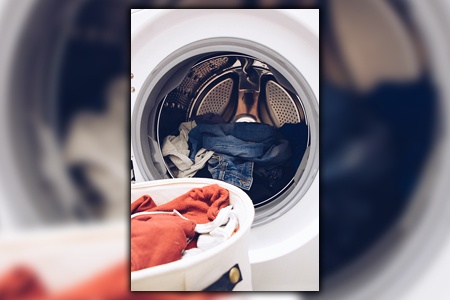
Can you put wet clothes in the dryer? Putting soaking wet clothes in the dryer can lead to various risks.
Increased Drying Time
Too wet clothes can trigger an unnecessary extension in drying time. This is because dryers are designed for dealing with moderately damp, not excessively wet laundry. As soaking wet clothes contain a significant amount of water, the dryer has to work harder and longer to evaporate that moisture effectively.
The process extends far beyond normal cycles, which might affect your daily routines significantly as you wait for the clothing to be properly dried. Therefore, placing overly moistened garments in your dryer should be avoided.
Not only does it pose potential risks to your machine's functionality, but it also disrupts efficient operation by leading to increased drying times.
Higher Energy Bills
Soaking wet clothes demands more energy to dry, hiking up your utility bills over time. Heavier loads require more power to spin the drum inside the dryer, increasing electricity usage.
Most dryers utilize an electric heating element or gas burner to generate heat that evaporates moisture from clothes; this process is significantly lengthier and more intensive when dealing with water-logged garments.
Turning on your dryer for longer exacerbates wear and tear and amplifies energy consumption. The cost may seem trivial initially, but consistent excess use eventually adds up, leading to higher energy bills.
Stiff Clothes
Clothes directly transitioned from a soaking wet state into the dryer often lose their softness in exchange for undesirable stiffness. The excessive moisture content forces the dryer to operate beyond its optimum efficiency levels, leading to imperfect results.
Fabric fibers can react adversely when subjected to intense heat without any preliminary drying stages. This process tightens up these fibers, causing your clothes, especially those made of cotton and wool, to become stiff and uncomfortable after drying.
To avoid this common issue associated with putting wet clothes in the dryer, one should consider employing other effective methods listed here for properly drying soaking wet garments.
Potential Damage to the Dryer
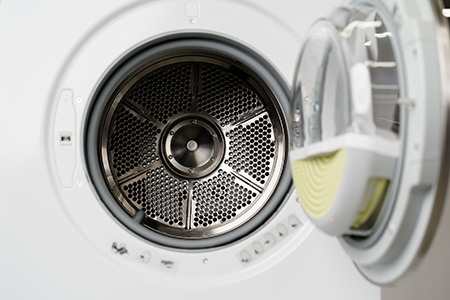
The excess weight and water from the wet clothes can strain the dryer drum, leading to cracks or warping. It can set the dryer off balance, causing the dryer to walk around the room or become squeaky.
This can affect the overall functioning of the dryer and may result in costly repairs or even replacement. Moreover, when wet clothes are placed directly into the dryer, there is a risk of water seeping into other parts of the machine, causing internal damage and possible malfunctioning.
Take precautions and avoid putting soaking wet clothes in the dryer to maintain its efficiency and longevity while ensuring safety during operation.
Excessive Water in Condenser Dryers
Condenser dryers are popular for many households due to their convenience and efficiency. However, when putting soaking wet clothes in these types of dryers, there is a risk of excessive water buildup.
This can be problematic because condenser dryers convert the moisture from the clothes into liquid form, which is then collected in a reservoir or drained away. If the clothes are too wet, the excess water may overwhelm the system and lead to leakage or flooding.
Ensure your clothes are correctly wrung out before placing them in a condenser dryer to prevent any potential issues with excessive water accumulation.
Tips for Properly Drying Soaking Wet Clothes
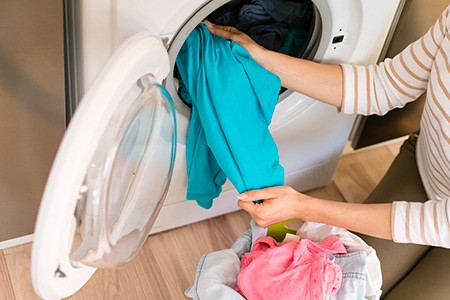
To properly dry soaking wet clothes, first, check the weight capacity of your dryer to ensure it can handle the load. Then, wring out the excess water from the clothes before placing them in the dryer.
If you're in a hurry, use a fan or hairdryer to expedite drying. Another option is ironing wet clothes or running a dehumidifier in the room for faster drying.
Check Your Dryer Type & Weight Capacity
Checking if your machine suits the job is essential before tossing your soaking wet clothes into the dryer. Different dryers have varying capacities and drying capabilities, so take a moment to see what yours can handle.
Excessively wet clothing can exceed the weight capacity of your dryer, leading to strain on its internal mechanisms. This slows down drying time and increases the risk of damage in the long run. This is a strong enough reason to not put soaking wet clothes in the dryer already.
Wring Out Clothes Before Placing Them in the Dryer
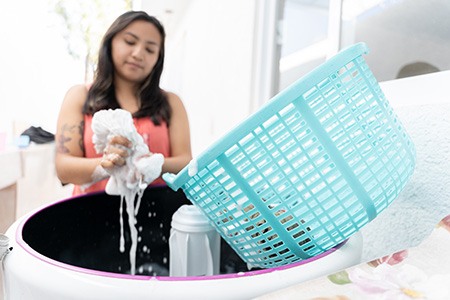
To ensure your clothes dry efficiently and without mishaps, wash any excess water before placing them in the dryer. This simple step can make a big difference in the drying process.
Removing as much moisture as possible reduces drying time and prevent potential damage to your dryer. It's important to note that dryers are designed to handle damp clothes, not actively dripping water.
Use a Fan or Hairdryer To Expedite Drying
You can use a fan or hairdryer to speed up the drying process for soaking wet clothes. Placing damp garments near a fan will promote air circulation and help remove moisture from the fabric.
You can also use a hairdryer on a low heat setting to target specific areas that are taking longer to dry. Just remember to move the dryer around continuously and keep it safe from the clothing to prevent overheating or damage.
These methods provide effective alternatives to the dryer and can save you time while ensuring your clothes dry appropriately without risking any potential damage.
Ironing Wet Clothes or Running a Dehumidifier
When ironing wet clothes, use a low to medium heat setting and ensure they are damp rather than soaking wet.
Ironing creates direct contact between the fabric and heat, helping to evaporate moisture faster.
Running a dehumidifier on drying mode is another option. These devices blow dry, warm air while reducing moisture in the surrounding area, effectively speeding up the drying time of your clothes.
FAQs Regarding Soaking Wet Clothes in the Dryer
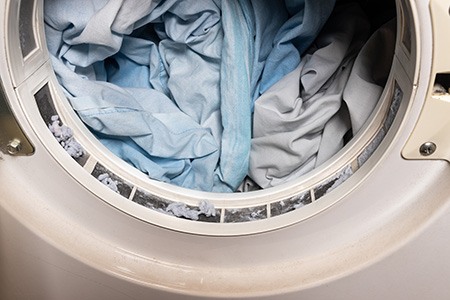
Below are common FAQs and their answers;
Are Dryer Sheets Bad For You?
Dryer sheets may seem harmless, but they can possibly harm your health according to some. Many dryer sheets contain fragrances and chemicals that can trigger asthma among other problems. There are plenty of dryer sheet alternatives you can opt for.
Some of these chemicals have been linked to health issues. Plus, dryer sheets leave behind a residue on your clothes that can irritate sensitive skin. If you're concerned about the potential adverse effects on your health, it's best to avoid using dryer sheets altogether.
Instead, consider alternatives like dryer balls or simply drying your clothes without added products. Your health will thank you!
What to Do With a Soaking Wet Blanket?
If you find yourself with a soaking wet blanket, it's essential to handle it properly to ensure adequate drying. One option is to lay it flat on a clean surface and gently press out as much excess water as possible.
You can then hang it up or lay it over a clothesline to air dry. Another method is to use an absorbent towel and carefully roll the wet blanket inside, applying gentle pressure to remove more moisture.
Once most of the water has been removed, you can proceed with drying methods such as using a fan or hairdryer set on low heat. Just remember that putting a soaking wet blanket in the dryer is not recommended, which can lead to potential damage and improper drying. Can you put soaking wet clothes in the dryer? No, and the same goes for blankets, maybe even more so due to the weight.
How Long Can Clothes Sit in the Washer Before Washing?
Leaving wet clothes in the washer for an extended time can lead to unpleasant odors and potential fabric damage. After 8-12 hours, bacteria and mildew can accumulate, resulting in a musty smell that is difficult to remove.
To prevent this, washing wet clothes immediately if left sitting overnight is advisable. Washing clothes with bleach can provide some flexibility in leaving them overnight. Still, generally, it's best not to leave wet clothes in the washer for more than 8-12 hours, according to experts from the Whirlpool Institute of Fabric.
Can Fabric Softener Be Used in a Washer?
Fabric softener can indeed be used in a washer to keep your clothes feeling soft and wrinkle-free. It reduces friction between fibers, resulting in less static cling and more comfortable fabrics.
However, it's important to note that fabric softeners can have downsides. The waxy residue left behind by these products can clog microfibers and towels, making it harder for the fabric to absorb water.
Additionally, many fabric softeners contain chemicals that harm our health and the environment. So while fabric softener is an option, it's worth considering the impact on your clothes and the world around us before making a decision.
Don’t Put Soaking Wet Clothes in the Dryer
Will soaking wet clothes ruin a dryer? Putting soaking wet clothes in the dryer is not recommended due to the potential risks. It can lead to increased drying time, higher energy bills, stiff clothes, and potential damage to the dryer itself.
Additionally, condenser dryers may struggle with excessive water when dealing with soaking wet clothes. To properly dry your clothes, check your dryer's weight capacity and wring out any excess water before placing them inside.
Consider using a fan or hairdryer to expedite drying or alternative methods such as air-drying or spin-drying for excessively wet garments. Remember your specific dryer's capabilities and prioritize safe and efficient clothing drying practices. Just make it a rule... no soaking wet clothes in the dryer.




